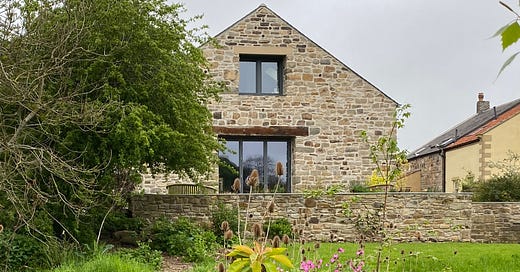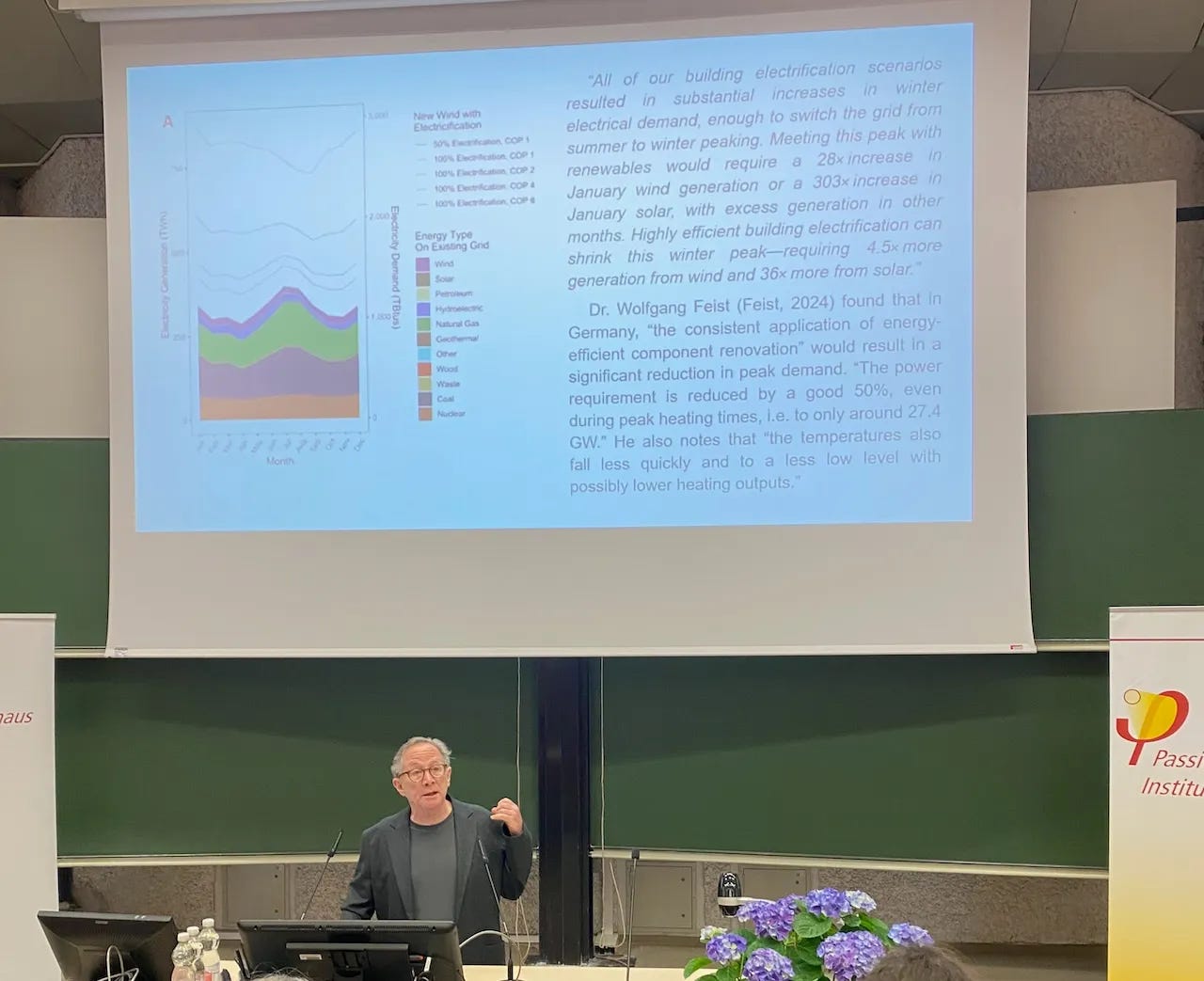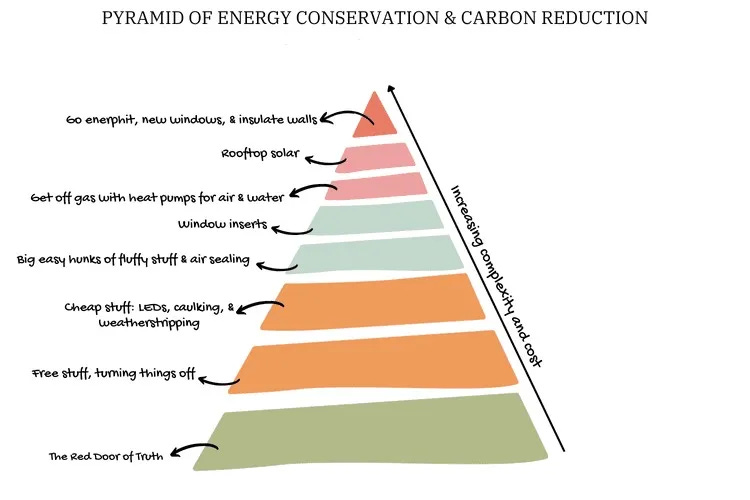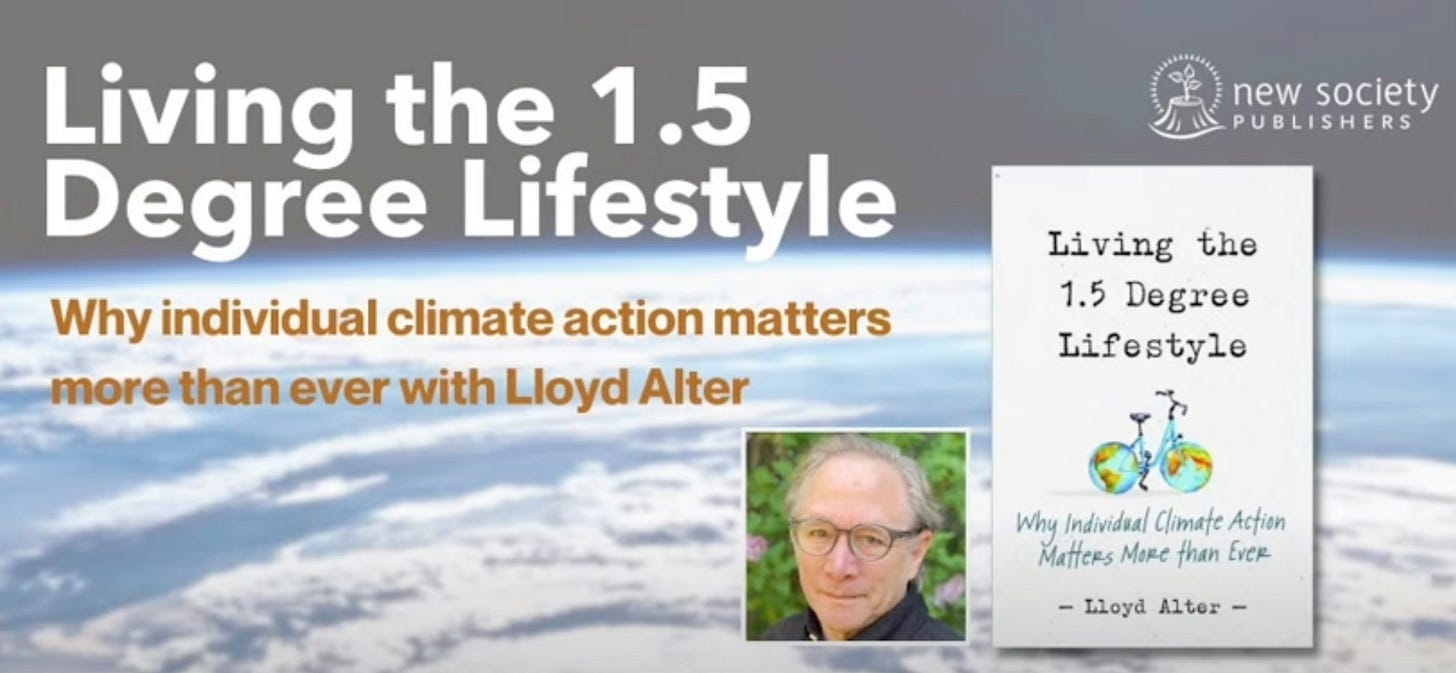Another look at "Fabric First" in building
Energy expert Michael Barnard looks at the insulation vs heatpumpification debate
Michael Barnard is a brilliant writer about energy issues; I read him regularly, even though I usually boycott writers who use tacky AI images (see Writers: Stop it with the AI images already. You're next.) He recently wrote about a subject we have discussed often in The “Fabric First” Trap: Decades of Studies Show Electrification Wins Every Time. USA people might say, “envelope first.” Barnard starts with (my emphasis):
In climate and energy policy, certain well-intentioned ideas gain outsized popularity despite persistent evidence against them. One such appealing but deeply problematic approach is the “fabric first” philosophy — the notion that building decarbonization must begin by aggressively insulating and sealing structures, only later electrifying their heating systems. On the surface, it’s intuitive: if buildings leak less heat, they need less energy. Yet decades of research across multiple countries continue to reveal that “fabric first” consistently delivers far less than promised, saddling property owners and governments with excessive costs while barely reducing fossil fuel dependency.”
He makes it sound like it is a question of choosing one or the other. First of all, until very recently, with the development of effective air-source heat pumps, there wasn’t a choice; if you wanted to reduce fossil fuel use, you had to insulate and seal. Today, nobody does a “fabric first” renovation and then electrifies later.
Secondly, years of evidence from the Passivhaus Institute and PHIUS demonstrate that appropriately done, “fabric first” delivers significant fossil fuel savings.
As evidence of his thesis, Barnard points to a University of Cambridge study “which offers a stark and cautionary tale.” The study found that insulation delivered a very small 7% gas savings, which disappeared in a few years. I was originally shocked by this study and looked at it closely in A 'Rebound Effect' May Cancel The Energy Benefits of Insulation. I noted at the time that these were hardly “fabric first” renovations. English housing is notoriously draughty, cold and uncomfortable, and most of these renovations involved simply filling cavity walls with styrofoam beads. As architect Mark Siddall told me,
"When people have a limited budget, they can not afford to heat their home to remain comfortable. Instead, they compromise comfort for lower bills. A shallow, fragmented retrofit helps to reduce bills; however, because retrofit has been undertaken in a half-hearted manner, occupants choose better comfort at the same similar cost to their pre-retrofit bills."
Barnard continues with studies from Wales, Germany, New Zealand and the USA, all confirming that yes, people like health and comfort and turn up the thermostat, which reduces energy savings. However, health and comfort are not only nice to have; they are what consumers want. Decades of research have shown that people don’t shell out money for elusive carbon savings; they do it for comfort, and the best way to get comfort is to do a deep retrofit to reduce the Mean Radiant Temperature of exterior walls. Barnard complains:
“Yet many policymakers and influencers remain fixated on ambitious envelope-first programs, repeatedly misled by overly optimistic modeling, persistent cultural biases toward efficiency, and disregard for behavioral realities.”
No, policymakers and influencers are often slow, but they understand the fundamental change wrought by the heat pump. The Biden administration spent billions promoting them, and they will soon be the only heat source available in Europe. Barnard concludes:
“Envelope improvements remain valuable, but only up to the point of Pareto optimality, where marginal benefits equal marginal costs. Beyond that point lies diminishing returns, wasted resources, and continued fossil fuel dependence.”
I may live in a green building bubble, but I think most architects, builders, and even authorities get this now. As Richard Erskine noted in 2021,
The 'retrofit community' generally have established an article of faith that 'deep retrofit' is essential. This is a belief that has very deep roots and predates concerns about the climate emergency. Key organisations in the public and private sector promote this belief. Their motivation is to create greater comfort in homes and to lower heating bills, and who can argue with this? The problem is that it isn’t a realistic strategy for reaching net zero in the fastest time possible.
Toby Cambray’s article in Passive House Plus, built on Erskine: “A basic fabric retrofit is relatively expensive, and heat pumps are getting better and cheaper; therefore we should do a bare minimum of fabric work and focus on deploying heat pumps.”
Harold Orr, who essentially invented the Passivhaus with his Saskatchewan Conservation House, was all in for the Pareto Principle, and going after “the big hunks, particularly in Canada:
"If you take a look at a pie chart in terms of where the heat goes in a house, you’ll find that roughly 10% of your heat loss goes through the outside walls.” About 30 to 40 % of your total heat loss is due to air leakage, another 10% for the ceiling, 10% for the windows and doors, and about 30% for the basement. “You have to tackle the big hunks,” says Orr, “and the big hunks are air leakage and uninsulated basement.”
I concluded after reading this:
"Doing an Energiesprong [deep retrofit] or complete rebuild of every house in North America would take forever and cost the Earth; cutting energy use by 50% or even 80% is achievable by following Harold Orr's prescription. Once you are there, it is not a stretch to switch to an air source heat pump and electrify everything, and you are no longer emitting carbon."
On the other hand, I was asked to address this issue at the International Passivhaus Conference in Innsbruck last spring, and I tried to make the case that it was still necessary to significantly reduce demand for energy, even with all electric heat pumps. My paper published in the proceedings listed a number of reasons one might still want to do deep energy retrofits to the Passivhaus EnerPhit standard:
Electrifying everything means demand will grow significantly. Converting transportation from gasoline and diesel, heating from natural gas, and industry from coal will create a vast demand for electricity while powering it all with renewables and zero-carbon sources will limit supply. Reducing demand in every form of electricity consumption should be a priority.
With buildings, it is the peak demand that matters. The electrical grid must be designed around peak demand under the worst conditions. Skylar Swinford and Zach Semke (Swinford & Semke, 2023) noted, “envelope-first” building energy efficiency is uniquely suited to address this winter heat load.” A study published in Nature (Buonocore, 2022) found that in the USA:
“All of our building electrification scenarios resulted in substantial increases in winter electrical demand, enough to switch the grid from summer to winter peaking. Meeting this peak with renewables would require a 28× increase in January wind generation or a 303× increase in January solar, with excess generation in other months. Highly efficient building electrification can shrink this winter peak—requiring 4.5× more generation from wind and 36× more from solar.”
Dr. Wolfgang Feist (Feist, 2024) found that in Germany, “the consistent application of energy-efficient component renovation” would result in a significant reduction in peak demand. “The power requirement is reduced by a good 50%, even during peak heating times, i.e. to only around 27.4 GW.” He also notes that “the temperatures also fall less quickly and to a less low level with possibly lower heating outputs.”
With renewables, we must design for resilience and intermittency: Passivhaus can work as a “thermal battery”, excluding or retaining heat when electricity is lost due to weather or lack of renewable energy. A network of “smart” Passivhaus buildings might well be controlled by utilities and controlled remotely at peak times, as water heaters often are, to shave the peak.
With Passivhaus, heat pumps are smaller. Many heat pumps are charged with refrigerants that are serious greenhouse gases; the commonly used R134a has a global warming potential of 1400 times that of CO2. Heat pumps leak; estimates in the UK are 6% per year. Since the heat pump's size is based on a building's heating and cooling demand, a Passivhaus design will get by with a significantly smaller unit, leaking less refrigerant. However, perhaps more critically, smaller heat pumps can be charged with hydrocarbon refrigerants like R-290 (propane,) which has a GWP of only three times that of CO2. For safety reasons, these units are limited in size. The efficiency of a Passivhaus design could make the difference between two heat pumps with two very different refrigerants.
Comfort and health still matter: Uninsulated walls and poor-quality windows significantly lower the mean radiant temperature, reducing comfort levels. They make humidity levels challenging to control, resulting in either uncomfortably dry air or the possibility of mould growth.
Barnard doesn’t mention the upfront or embodied carbon emissions of a deep energy retrofit, but they can be considerable if it’s not done properly. That’s why, in the end, I agree with Barnard that we need a mix of Pareto-level retrofits plus heat pumps. That’s why my “pyramid of energy conservation and carbon reduction” called for the cheap and easy stuff first, and then the heat pump.
Michael Barnard makes it sound like everyone is pushing insulation before heatpumpification, but I am not sure anyone outside of Alberta and the USA fossil fuel industry still is; even the most diehard Passivhaus fan recognizes that we have to electrify everything. We need both.
The air-source heat pump changed everything, and everybody knows it. Barnard is fighting the last war.
Special Offer!
I do not want to put up a paywall on this site, but it provides a meaningful portion of my income. So here’s a limited time offer: I will send a signed copy of the print edition of “Living the 1.5 Lifestyle” to anyone in the USA or Canada who signs up for a one-year subscription (C$50, cheap at about US$34.95 ) If you live in London or Glasgow, I will bring them personally in late May, and we can arrange a pickup.









So much depends on the type of building and its condition. If it needs new windows and cladding, then consider adding some insulation - certainly air tighten the walls with a membrane. If it needs a new roof, upgrade the thermal performance at that time.
I've done analyses for century-old masonry bearing wall municipal buildings and concluded that insulating the walls doesn't make economic sense. I have a rough guideline for my area (New England, USA - hoping to become the next Canadian province) that I like to see the design load of a building get down to 20 BTU/hour/sf (63 W/m2) before converting to heat pumps.
In my online classes about decarbonization (Heatspring and Fine Homebuilding), I stress that when making these enclosure decisions it's important to identify all of the existing deficiencies that go beyond energy use. Is there mold? Water in the foundation? Pests? Recurring frozen pipes and ice dams? The value of thermal enclosure upgrades may be far more significant in rectifying these than in the energy saved.
Once the decision to convert to HPs is made, it's important to understand the real design load of the building. Fossil fuel systems are almost always oversized. We datalogged some of the aforementioned masonry municipal buildings during a very cold spell. They had existing NG heating systems sized at 50 BTU/hr/sf, our calcs showed 30, and actual peak was under 20. That saves a lot on heat pump costs, and also makes it easier to fit the new systems in the building.
I think focusing on insulation as the most important component of "fabric first" is a mistake. Airsealing is cheap and essential.
Some blower door operators give the usual report about airtightness in air changes per hour at 50 Pascal (---ach50) but also put airtightness in the form of how big a hole in the building envelope a given level is equivalent to. So "your house leaks like there's a 10cm x10cm hole in the outside wall" is a lot better than "your house leaks like there's a 50cm x 50cm hole in the wall."